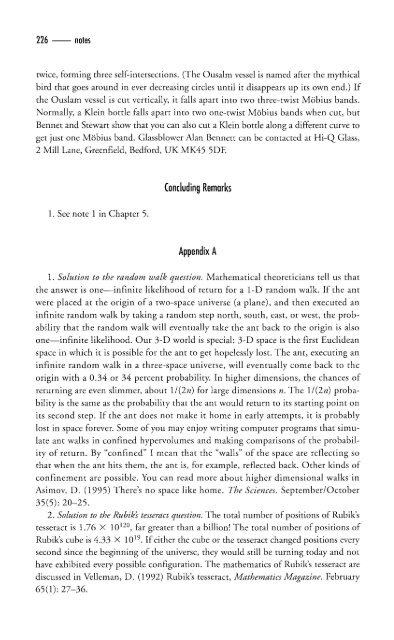clifford_a-_pickover_surfing_through_hyperspacebookfi-org
clifford_a-_pickover_surfing_through_hyperspacebookfi-org
clifford_a-_pickover_surfing_through_hyperspacebookfi-org
Create successful ePaper yourself
Turn your PDF publications into a flip-book with our unique Google optimized e-Paper software.
226 notes<br />
twice, forming three self-intersections. (The Ousalm vessel is named after the mythical<br />
bird that goes around in ever decreasing circles until it disappears up its own end.) If<br />
the Ouslam vessel is cut vertically, it falls apart into two three-twist Mobius bands.<br />
Normally, a Klein bottle falls apart into two one-twist Mobius bands when cut, but<br />
Bennet and Stewart show that you can also cut a Klein bottle along a different curve to<br />
get just one Mobius band. Glassblower Alan Bennett can be contacted at Hi-Q Glass,<br />
2 Mill Lane, Greenfield, Bedford, UK MK45 5DF.<br />
Concluding Remarks<br />
1. See note 1 in Chapter 5.<br />
Appendix A<br />
1. Solution to the random walk question. Mathematical theoreticians tell us that<br />
the answer is one—infinite likelihood of return for a 1-D random walk. If the ant<br />
were placed at the origin of a two-space universe (a plane), and then executed an<br />
infinite random walk by taking a random step north, south, east, or west, the probability<br />
that the random walk will eventually take the ant back to the origin is also<br />
one—infinite likelihood. Our 3-D world is special: 3-D space is the first Euclidean<br />
space in which it is possible for the ant to get hopelessly lost. The ant, executing an<br />
infinite random walk in a three-space universe, will eventually come back to the<br />
origin with a 0.34 or 34 percent probability. In higher dimensions, the chances of<br />
returning are even slimmer, about l/(2n) for large dimensions n. The l/(2») probability<br />
is the same as the probability that the ant would return to its starting point on<br />
its second step. If the ant does not make it home in early attempts, it is probably<br />
lost in space forever. Some of you may enjoy writing computer programs that simulate<br />
ant walks in confined hypervolumes and making comparisons of the probability<br />
of return. By "confined" I mean that the "walls" of the space are reflecting so<br />
that when the ant hits them, the ant is, for example, reflected back. Other kinds of<br />
confinement are possible. You can read more about higher dimensional walks in<br />
Asimov, D. (1995) There's no space like home. The Sciences. September/October<br />
35(5): 20-25.<br />
2. Solution to the Rubik's tesseract question. The total number of positions of Rubik's<br />
tesseract is 1.76 X 10 I2 °, far greater than a billion! The total number of positions of<br />
Rubik's cube is 4.33 X 10 19 . If either the cube or the tesseract changed positions every<br />
second since the beginning of the universe, they would still be turning today and not<br />
have exhibited every possible configuration. The mathematics of Rubik's tesseract are<br />
discussed in Velleman, D. (1992) Rubik's tesseract, Mathematics Magazine. February<br />
65(1): 27-36.







